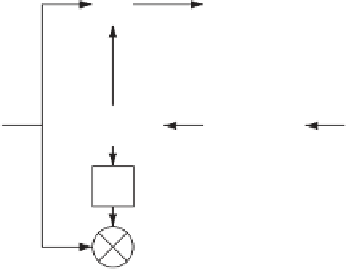Global Positioning System Reference
In-Depth Information
I
Lowpass
filter
PRN code
Incoming
signal
NCO carrier
generator
Carrier loop
filter
Carrier loop
discriminator
90°
Lowpass
filter
Q
FIGURE 7.7. Costas loop used to track the carrier wave.
and the input signal. The
goal of the Costas loop is to try to keep all energy in the
I (in-phase) arm
. To keep the energy in the
I
arm, some kind of feedback to the
oscillator is needed. If it is assumed that the code replica in Figure 7.7 is perfectly
aligned, the multiplication in the
I
arm yields the following sum:
D
k
1
2
D
k
1
2
D
k
(
n
)
cos
(ω
IF
n
)
cos
(ω
IF
n
+
ϕ)
=
(
n
)
cos
(ϕ)
+
(
n
)
cos
(
2
ω
IF
n
+
ϕ),
(7.19)
where
is the phase difference between the phase of the input signal and the phase
of the local replica of the carrier phase. The multiplication in the quadrature arm
gives the following:
D
k
ϕ
1
2
D
k
1
2
D
k
+
ϕ).
(7.20)
If the two signals are lowpass filtered after the multiplication, the two terms with
the double intermediate frequency are eliminated and the following two signals
remain:
(
n
)
cos
(ω
IF
n
)
sin
(ω
IF
n
+
ϕ)
=
(
n
)
sin
(ϕ)
+
(
n
)
sin
(
2
ω
IF
n
I
k
1
2
D
k
=
(
n
)
cos
(ϕ),
(7.21)
Q
k
1
2
D
k
=
(
n
)
sin
(ϕ).
(7.22)
To find a term to feed back to the carrier phase oscillator, it can be seen that the
phase error of the local carrier phase replica can be found as
Q
k
I
k
1
2
D
k
(
n
)
sin
(ϕ)
=
(ϕ)
=
tan
(ϕ),
(7.23)
1
2
D
k
(
n
)
cos
tan
−
1
Q
k
I
k
.
ϕ
=
(7.24)
From Equation (7.24), it can be seen that the phase error is minimized when the
correlation in the quadrature-phase arm is zero and the correlation value in the in-
phase arm is maximum. The arctan discriminator in Equation (7.24) is the most
precise of the Costas discriminators, but it is also the most time-consuming. Ta-
ble 7.1 describes other possible Costas discriminators.


















Search WWH ::

Custom Search